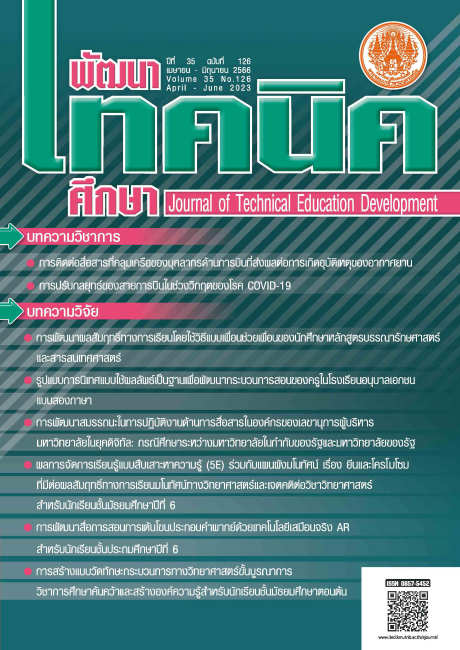Ambiguous Communication of Aviation Personnel Contributing to Aircraft Accidents
Main Article Content
บทคัดย่อ
บทความวิชาการฉบับนี้ มุ่งศึกษาเรื่องการติดต่อสื่อสารที่คลุมเครือของบุคลากรด้านการบินส่งผล กระทบ ต่อความปลอดภัยของผู้โดยสาร และแนวทางแก้ปัญหาของการติดต่อสื่อสารที่คลุมเครือ เพื่อเป็นการ พัฒนาการติดต่อสื่อสารที่ดีภายในองค์กร และสามารถนำไปปรับใช้กับองค์กรได้จริง
จากการศึกษาพบว่า การติดต่อสื่อสารที่คลุมเครือของบุคลากรด้านการบินเป็นสาเหตุที่ทำให้เกิด ความไม่เข้าใจกันระหว่างบุคลากร อาจส่งผลกระทบต่อความปลอดภัยของผู้โดยสารที่มาใช้บริการ ซึ่งสิ่งที่ อุตสาหกรรมการบินควรจะมี คือแนวทางการพัฒนาการติดต่อสื่อสารที่มีประสิทธิภาพ ไม่ว่าจะเป็นด้านภาษา มีการใช้ภาษาอังกฤษในการสื่อสาร ข้อความหรือคำพูดต้องมีความกะทัดรัด มีใจความสำคัญ ในด้าน สิ่งแวดล้อม มีการวางแผนการทำงานและตรวจอุปกรณ์ต่าง ๆ ก่อนการปฏิบัติงาน ด้านบุคลากร บุคลากรแต่ละองค์กรมีการหาความรู้เพิ่มเติมเพื่อเพิ่มประสิทธิภาพของตนเอง และด้านองค์กร แต่ละองค์กรมีการจัดลำดับขั้นตอนก่อนการปฏิบัติงาน เมื่ออุตสาหกรรมการบินมีการพัฒนาการติดต่อสื่อสารให้มีประสิทธิภาพ ปัญหาความไม่ปลอดภัยหรือการเกิดอุบัติเหตุของผู้โดยสารก็จะมีความเสี่ยงที่จะเกิดขึ้นน้อยที่สุด นอกจากนี้ยังสร้าง ภาพลักษณ์และความน่าเชื่อถือขององค์กรได้ดียิ่งขึ้นอีกด้วย
Article Details

อนุญาตภายใต้เงื่อนไข Creative Commons Attribution-NonCommercial-NoDerivatives 4.0 International License.
เอกสารอ้างอิง
Dean E. Hewes. (2009). The Influence of Communication Processes on Group Outcomes: Antithesis and Thesis, Human Communication Research, Volume 35 (2), 249–271.
Maclellan, E. (2014). How might teachers enable learner self-confidence? A review study. Educational Review, 66 (1), 59-74.
Garosi E, and others (2020). Concerns About Verbal Communication in the Operating Room: A Field Study. Human Factors. 62(6):940-953.
Jentsch, F. G., Salas, E., Sellin-Wolters, S., Bowers, C. A. (1995). Crew coordination behaviors as predictors of problem detection and decision making times. Proceedings of the Human Factors and Ergonomics Society Annual Meeting (Vol. 39, No. 20, pp. 1350–1353). Los Angeles, CA: SAGE.
Kalantari, R., and others. (2019). Translation and psychometric properties of the Persian version of oxford non-technical skills 2 system: Assessment of surgical teams’ non- technical skills in orthopedic surgery wards. The Archives of Bone and Joint Surgery, 7, 173–181.
ICAO . (2010). Manual on the implementation of ICAO language proficiency requirements (1st ed). Retrieved from International Civil Aviation Organization: www4.icao.int/aelts/uploads/icaodoc9835 (2nd ed. pdf).
Kim, H., Billington, R. (2018). Pronunciation and comprehension in English as a ingua franca communication: Effect of L1 influence in international aviation communication. Applied linguistics, 39(2), 135–158.
Kim H. (2018). What constitutes professional communication in aviation: Is language proficiency enough for testing purposes?. Language Testing.35 (3): 403-426.
Douglas, D. (2000). Assessing language for specific purposes. Cambridge, UK: Cambridge University Press.
Knoch, U. (2014). Using subject specialist to validate an ESP rating scale: The case of the International Civil Aviation Organization (ICAO) rating scale. English for Specific Purposes, 33, 77–86.
Estival, D., Farris, C., Molesworth, B. (2016). Aviation English: A lingua franca for pilots and air traffic controllers. Abingdon, UK: Routledge.
Mackay, R., Mountford, A. (1978). English for specific purposes: A case study approach. London: Longman.
ICAO. (2004). Manual on the implementation of ICAO language proficiency requirements. Montreal, Canada: International Civil Aviation Organization.
Lave, J., Wenger, E. (1991). Situated learning: Legitimate peripheral participation. Cambridge, UK: Cambridge University Press.
Fields, R. E., Wright, P. C., Marti, P., Palmonari, M. (1998). Air traffic control as a distributed cognitive system: A study of external representations. In Proceedings of the 9th European Conference on Cognitive Ergonomics (pp. 85–90). Roquencourt, France.
Manias, E., McNamara, T. (2016). Standard setting in specific-purpose language testing: What can a qualitative study add? Language Testing, 33(2), 235–249.
Howard, J. W. (2008). Tower, am I cleared to land?: Problematic communication in aviation discourse. Human Communication Research, 34, 370–391.
Hutchins, E., Klausen, T. (1996). Distributed cognition in an airline cockpit. In Engeström, Y., Middleton, D. (Eds.), Cognition and communication at work. Cambridge, MA: Cambridge University Press.
Morrow, D., Rodvold, M. (1998). Communication issues in air traffic control. In Smolensky, M., Stein, E. (Eds.), Human factors in air traffic control (pp. 421– 456).
New York: Academic Press.
Jacoby, S., McNamara, T. (1999). Locating competence. English for Specific Purposes, 18(3), 213–241.


